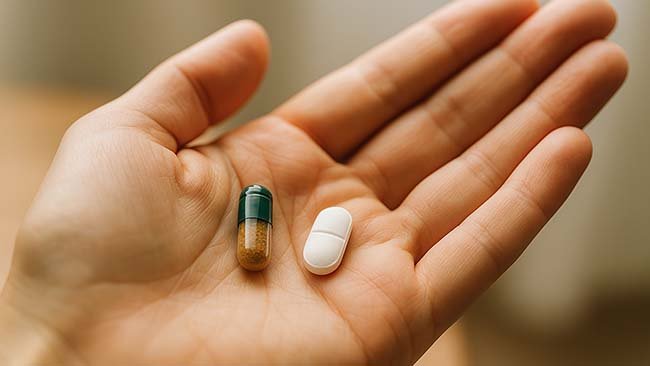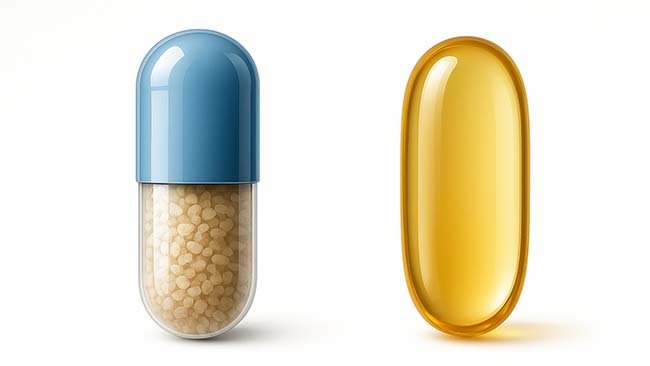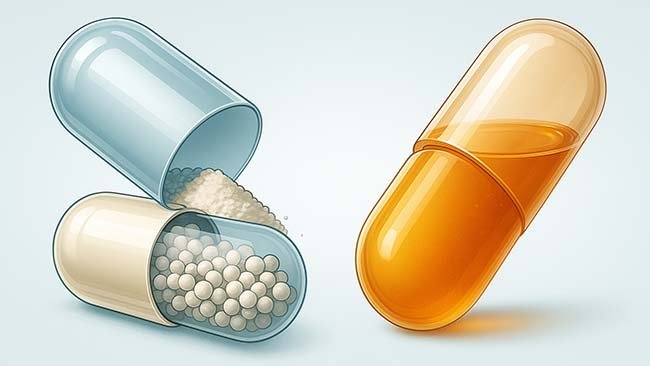Choosing between capsules vs tablets is about far more than the shape of the pill or whether it’s easy to swallow. The dosage form you choose can influence how well a product works, how quickly its benefits appear, how stable it remains throughout its shelf life, and what it ultimately costs to produce. These differences matter to everyday consumers, healthcare practitioners, and manufacturers alike—because the form determines not just convenience, but overall performance.
Whether you’re a health-focused consumer comparing supplement labels or part of a pharmaceutical or nutraceutical team planning a new formulation, understanding the distinctions between dosage forms helps you make decisions that are based on how each form truly functions rather than how a product is marketed. With clearer insight, you can evaluate absorption speed, ingredient compatibility, stability, dose flexibility, and long-term product reliability more confidently.
This article walks through how each form is made, how it behaves in the body, key pros and cons, and when one format clearly has an advantage. You’ll also see comparison tables and practical examples to make the science easy to apply in real-world decisions.
Capsules are small, cylindrical containers made from a gelatin or plant-based polymer shell. Inside that shell, manufacturers can fill powders, granules, beadlets, oils, or semi-solid pastes. The capsule's shell breaks down in the digestive tract after swallowing, releasing its contents for absorption into the body.
Hard-shelled capsules
Hard capsules are the classic “body and cap” design: two hollow halves that slide and lock together.
• Typically filled with dry powders, pellets, or multiparticulate beads.
• Certain designs can also hold liquids or semi-liquids, sealed after filling to prevent leakage.
• Often used when the formulation doesn’t compress well into a tablet or when multiple bead types need to be combined in one dose.
Soft-gel capsules
Softgels are formed as a sealed, flexible shell around a liquid or semi-solid fill.
• The shell is usually slightly thicker and more elastic, often transparent or semi-transparent.
• Commonly used for oils, lipid-based formulations, and sensitive ingredients that benefit from being fully encapsulated.
• Popular formats for fat-soluble vitamins, fish oil, CoQ10, herbal extracts, and fast-acting supplements.
After you swallow a capsule, the shell quickly absorbs moisture and starts to soften. Within minutes, it dissolves and the contents disperse into the stomach or upper intestine as loose powder, granules, or liquid.
Because there is no solid mass that needs to break apart, many capsules have a faster onset than standard tablets. Liquid-filled capsules in particular can be absorbed rapidly, which is one reason they are often chosen for ingredients where quick action is desirable.

Tablets are solid oral doses made by compressing a blend of active ingredients and excipients into a firm, stable unit. Those excipients can include:
• Binders to hold the tablet together
• Fillers to give the tablet bulk
• Disintegrants to help it break apart
• Lubricants to aid manufacturing
• Coatings to improve swallowing, taste, or release profile
Tablets can be round, oval (caplets), scored, film-coated, sugar-coated, chewable, effervescent, delayed-release, extended-release, or orally dissolving. This variety makes tablets extremely versatile for both prescription medicines and supplements.
A tablet does not dissolve all at once. First, it must disintegrate into smaller fragments; then those fragments dissolve and release the drug or nutrient into surrounding fluids.
Disintegration and dissolution depend on:
• The compression force used when the tablet was made
• The type and amount of disintegrants
• Whether there is a coating and what that coating is designed to do
• Interactions between excipients and the active ingredient
Fast-acting tablets use disintegrants that cause the tablet to fall apart quickly. Extended-release tablets are engineered to erode slowly or release the active layer by layer, stretching the effect over many hours.
Because these parameters can be controlled with modern tableting technology, manufacturers can design tablets with very specific release behaviors, from rapid onset to once-a-day sustained release.
Many everyday vitamins come in forms chosen for technical reasons, not just for marketing. The table below shows how common vitamin categories are often delivered and why those forms are preferred.
Table – Typical Dosage Forms for Common Vitamin Types
|
Vitamin Type |
Common Dosage Form |
Why This Form Is Often Chosen |
|
Fat-soluble vitamins (A, D, E, K) |
Soft-gel capsules |
Oils improve absorption; softgel shell helps protect against oxidation and light exposure. |
|
Water-soluble vitamins (Vitamin C, B-complex) |
Tablets |
High dose capacity, good stability, and cost-effective for daily multivitamin products. |
|
Specialty blends (multivitamin + herbs, etc.) |
Hard capsules |
Flexible filling of multiple powders or pellets; keeps different ingredients separated to reduce interactions or instability. |
This everyday example makes the capsules vs tablets choice more concrete: formulation needs, ingredient stability, and dose size often decide the dosage form long before the product reaches store shelves.

Many comparisons simply list pros and cons without explaining what’s behind them. Below, each difference is tied to the underlying science so you can see why one form might be better in a certain situation.
Capsules
Capsules are extremely flexible in what they can hold:
• Dry powders and granules
• Multiparticulate beads with different coatings
• Oils and lipid-based systems
• Semi-solid fills and suspensions
Because the shell itself provides structure, capsules often need fewer binders or compressible excipients. They are especially useful for:
• Ingredients that are sensitive to high compression force
• Formulas that combine multiple beadlets for staged release
• Strong-smelling or bitter ingredients that must be fully enclosed
Tablets
Tablets, by contrast, are built by compressing powders into a solid block. They typically require:
• Binders to give mechanical strength
• Lubricants so the tablet ejects smoothly from the die
• Disintegrants to help the compressed mass break apart
The upside is that this process is highly automated and efficient, making tablets the dominant format for large-scale, high-volume products.
Why it matters
• Fragile or complex formulations often perform better in a capsule.
• High-dose products and very large production runs usually favor tablets.
• When cost and speed of manufacturing are critical, tablets often win.
Capsules tend to dissolve quickly because the shell breaks apart and releases the contents in free form. This often translates to:
• Faster onset of action, especially for liquid or fine-powder fills
• Less variability in how the contents disperse in the stomach
Tablets may take longer to start working because they must disintegrate before the active ingredient can dissolve. However, with effervescent technology, orally disintegrating tablets, and fast-disintegrating excipients, tablets can also be designed for rapid release when needed.
In short, capsules often have a natural speed advantage, but well-designed tablets can match that when rapid action is a priority.
One of the biggest strengths of tablets is their stability:
• The solid, compressed structure resists moisture and heat better than many capsule shells.
• Shelf life is often longer, which is especially valuable for global distribution and warm or humid climates.
Gelatin and some vegetarian capsule shells are more sensitive to humidity and temperature. They may soften, deform, or stick together if storage conditions are poor. Oils in softgels can also oxidize over time without proper protection.
For ingredients like Vitamin C that are prone to degradation, tablet formulations often achieve better long-term stability than capsule formats.

Once swallowed, a tablet begins a multi-step journey through your digestive system:
1. Disintegration
The tablet first breaks into granules or fragments. This process is influenced by compression force, disintegrant type, and whether a coating delays contact with fluid.
2. Dissolution
The active ingredient must then dissolve into the fluid environment of the stomach or intestine. Coatings and excipient choice can accelerate or slow this step.
3. Absorption and Distribution
The active ingredient's journey involves absorption into the bloodstream, transit through the liver, and distribution to target tissues to elicit its therapeutic response.
Different tablet designs tweak these steps:
• Enteric-coated tablets resist stomach acid and only dissolve in the intestine, protecting acid-sensitive actives.
• Extended-release tablets are engineered to erode gradually, maintaining a steady level of drug or nutrient over many hours.
• Orally disintegrating tablets (ODTs) are designed to fall apart on the tongue without water, useful for children, seniors, or people with swallowing difficulties.
Because these behaviors can be controlled very precisely, tablets are often chosen when tight control over dosing and timing is essential. They are also the most practical option for products that require a high amount of active ingredient in a single unit.
Capsules follow a slightly different path once they reach the stomach:
1. Shell hydration and dissolution
The gelatin or plant-based shell quickly takes up moisture and softens. Within a short time, it dissolves entirely.
2. Release of contents
The powders, beadlets, or liquid inside are released in their original form, without needing mechanical disintegration.
3. Dissolution and absorption
From that point forward, the active behaves much like a tablet’s contents: it dissolves, is absorbed into the bloodstream, processed by the liver, and distributed to tissues.
For consumers, this often translates to two obvious advantages:
• Faster perceived onset – especially with liquid-filled capsules or very fine powders.
• Minimal taste and odor – the shell completely surrounds the active, which is helpful for pungent or bitter ingredients.
The internal fill also influences performance:
• Liquid formulas are usually absorbed the fastest and are common in products where rapid bioavailability is important.
• Pellet-filled capsules can be formulated to release multiple ingredients at different times in the digestive tract.
• Powder capsules provide consistent dosing for vitamins, herbs, and nutraceuticals.
• Softgels are ideal for oils and fat-soluble vitamins that need protection from oxygen and require a lipid carrier for absorption.
Some capsule designs use delayed-release shells that resist stomach acid and open only in the intestine—useful for probiotics, enzymes, and other ingredients that would otherwise be damaged by gastric conditions.
The table below summarizes how capsules and tablets compare across practical criteria for consumers, manufacturers, and product developers.
Table – Key Functional Differences Between Capsules and Tablets
|
Criteria |
Capsules |
Tablets |
|
Speed of action |
Shell dissolves quickly; contents disperse fast. Liquid or fine-powder fills act very fast. |
Typically slower to begin acting unless formulated as fast-acting or ODT; extended-release options provide gradual effect. |
|
Dosage capacity |
Limited by shell volume; high doses may require taking multiple capsules. |
Can carry high active loads in a single unit; well suited for strong or high-dose formulations. |
|
Stability & shelf life |
Shell and oils can be sensitive to heat and humidity; often need careful packaging. |
Generally more robust and stable; often longer shelf life and better suited for challenging climates. |
|
Taste & odor masking |
Excellent taste and odor masking because the shell fully encloses the contents. |
Coatings effectively mask the taste of medication, while uncoated tablets can have a grittier texture and a lingering aftertaste. |
|
Cost & manufacturing |
Capsule shells add material cost; filling speeds are lower and equipment is more specialized. |
Typically the most economical format; high-speed presses can manufacture very large volumes efficiently. |
|
Formulation flexibility |
Accepts powders, oils, beadlets, and complex multiparticulate systems. |
Ideal for powders; offers a wide range of release profiles via coatings and matrix technologies. |
|
User experience |
Often perceived as smoother and easier to swallow; gentle on taste and smell. |
Familiar and widely available, but large tablets can be harder to swallow for some users. |
Both dosage forms have strong, valid use cases. Capsules shine in sensory experience and speed, while tablets dominate in dose flexibility, stability, and cost-effectiveness. That balance is why both remain essential in pharmacies, supplement aisles, and professional healthcare settings.

Choosing between capsules vs tablets isn’t just a matter of habit or brand loyalty. It’s about matching the dosage form to your comfort, ingredient type, dose requirement, budget, and health needs.
Consider the following:
• If you dislike bitter tastes or are very sensitive to smell, capsules typically provide a more neutral experience. They are especially helpful for botanical extracts, concentrated oils, and blends that would taste unpleasant in tablet form.
• If you need higher dosages, long storage life, or a lower price per dose, tablets are often the better choice. They support precise dosing, can be engineered for fast or slow release, and are available in many formats (chewable, ODT, sustained-release).
• If you have dietary restrictions, carefully reviewing ingredient labels is crucial. Some capsules contain animal-derived gelatin unless marked as vegetarian or vegan. Tablets may include certain excipients, colorants, or allergens that sensitive individuals need to avoid.
If you are taking a prescription medication or have a medical condition, it’s important to ask a healthcare professional before crushing tablets or opening capsules. Some products depend on their intact form for proper release, and altering them can change how much or how quickly the active ingredient enters your system.
When evaluating capsules vs tablets, it becomes clear that both dosage forms are effective, but each serves different priorities. Capsules deliver speed, sensory comfort, and versatility in formulation, while tablets offer superior stability, higher dosing potential, and lower manufacturing costs. Recognizing these distinctions enables better decision-making for everyday consumers and for professionals developing new products.
• Capsules: speed, taste masking, and flexibility for complex or sensitive formulations.
• Tablets: lower cost, high dose capacity, extended stability, and a wide range of release options.
As the supplement and pharmaceutical markets evolve, new technologies like delayed-release vegetarian capsules, orally dissolving tablets, and advanced beadlet systems continue to appear. These innovations don’t replace the basic capsules vs tablets choice; they refine it.
Next time you compare products on a shelf, look beyond the marketing claims on the label. By understanding what each dosage form can and cannot do, you can choose the option that better fits your body, your routine, and your long-term health goals.